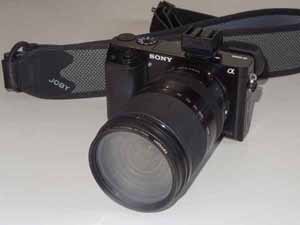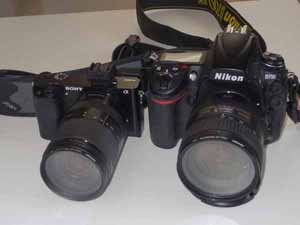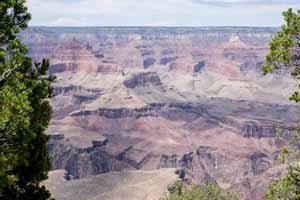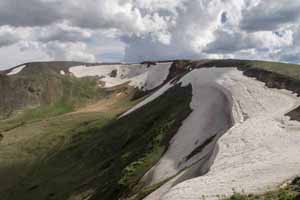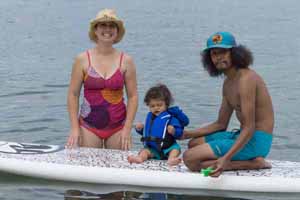Online Magazine
Recent Posts
- Safeguard your Cellphone Photos
- Black & White to Color – Instantly
- Wearing Many Hats
- Video Roundup
- Rescuing Your Blurry Pictures
- Showing Their Age
- What is Your Angle?
- Panorama Photos
- Humorous Photos
- Close Ups
- Fisheye Pictures
- Photo Antiquities
- Printing Big
- Appreciating Scale
- Celebrity Sightings
Tags
More Places to Go
- Free "How-To" Books “How To” books for popular cameras 0
- Vist Us on Facebook keep in touch with us on Facebook 2
Archives
- July 2023 (1)
- March 2023 (2)
- February 2023 (1)
- December 2022 (1)
- October 2022 (1)
- September 2022 (8)
- August 2022 (9)
- July 2022 (1)
- June 2022 (1)
- June 2021 (1)
- May 2021 (1)
- March 2021 (5)
- February 2021 (4)
- January 2021 (2)
- April 2019 (1)
- March 2019 (1)
- February 2019 (1)
- October 2018 (2)
- April 2018 (1)
- March 2018 (4)
- February 2018 (1)
- November 2017 (1)
- August 2017 (1)
- June 2017 (1)
- April 2017 (1)
- March 2017 (5)
- February 2017 (2)
- January 2017 (1)
- October 2016 (1)
- September 2016 (1)
- August 2016 (1)
- July 2016 (1)
- May 2016 (1)
- April 2016 (1)
- March 2016 (2)
- February 2016 (1)
- January 2016 (2)
- December 2015 (1)
- November 2015 (1)
- October 2015 (3)
- April 2015 (1)
- March 2015 (5)
- February 2015 (1)
- January 2015 (4)
- December 2014 (2)
- November 2014 (5)
- October 2014 (2)
- September 2014 (1)
- August 2014 (2)
- July 2014 (1)
- May 2014 (1)
- April 2014 (5)
- March 2014 (5)
- December 2013 (2)
- November 2013 (18)
- October 2013 (1)
- September 2013 (1)
- August 2013 (1)
- July 2013 (1)
- June 2013 (3)
- May 2013 (1)
- April 2013 (2)
- March 2013 (1)
- February 2013 (1)
- January 2013 (1)
- December 2012 (1)
- November 2012 (2)
- October 2012 (2)
- September 2012 (5)
- August 2012 (2)
- July 2012 (1)
- June 2012 (1)
- May 2012 (1)
- April 2012 (4)
- March 2012 (1)
- February 2012 (1)
- January 2012 (3)
- December 2011 (1)
- November 2011 (3)
- October 2011 (1)
- September 2011 (2)
- August 2011 (2)
- June 2011 (3)
- May 2011 (4)
- April 2011 (8)
- March 2011 (8)
- February 2011 (10)
- January 2011 (6)
- December 2010 (11)
- November 2010 (14)
- October 2010 (6)
- September 2010 (12)
- August 2010 (2)
- July 2010 (4)
- June 2010 (3)
- May 2010 (1)
- April 2010 (1)
- March 2010 (2)
- February 2010 (1)
- January 2010 (1)
- December 2009 (1)
- November 2009 (2)
- October 2009 (2)
- September 2009 (1)
- August 2009 (3)
- July 2009 (2)
- June 2009 (1)
- May 2009 (2)
- April 2009 (1)
- March 2009 (2)
- February 2009 (1)
- January 2009 (3)
The Sony A6000 Mirrorless
14th August 2014
My 6300-Mile Field Test
On our recent vacation, my camera of choice was Sony’s newest mirrorless camera. While I also brought a much larger Nikon D700 conventional DSLR, I relied mostly on the the Sony A6000. As a comparison, I captured about 150 images with the Nikon D700 and more than a thousand images with the Sony A6000.
My setup was the A6000 coupled with Sony’s 18-200mm lens. This combination is lightweight and compact, produces quality images and just happens to fit beneath the driver’s seat for fast, convenient access.
Hopefully, the following photographic sampler illustrates the A6000’s versatility. I’ll add a few techie details afterwards.
I suppose it doesn’t matter than I traveled 6300 miles with the camera other than I used it under a variety of conditions.
My “film” was a 32GB SD card, but I never filled it with the 200 pictures a day (the camera was set to record simultaneous RAW and JPG images). All in all, I’m very happy with the images that the camera produced. The one small gotcha is that the A6000 has a short battery life – probably due to the electronic viewfinder. Thankfully, I had an extra battery that I carried along.
Since this is my third Sony mirrorless camera, you can safely assume that I’d recommend this camera to others. In fact my daughter must have agreed with my assessment and purchased one.
For those interested, here’s a few of the technical specs for the A6000:
Sony A6000 os a mirrorless with a 24MP sensor. One of the reasons for choosing this camera is its fast and accurate hybrid focusing system that allows up to 11 frames per second capture. Other proven features are its “sweep panorama”, automated HDR capture, easy exposure bracketing, and Sony’s proven video recording.
List price for the A6000 body without lens is $650. The 18-200mm lens cost $850, more than the body but this single lens allowed me to enjoy the scenery without clutter of additional lenses.
Written by: Arnie Lee
Rapid Fire Nikon D4s
17th April 2014
How does 11 frames per second sound?
At the Wedding and Portrait Photographers International Expo last month in Las Vegas, I got a chance to handle Nikon’s newly announced D4s camera.
Although it’s lighter than the D4, it has a remarkable 16MP sensor that’s superb at high ISO settings. In fact we saw a demonstration of the camera at an ISO setting of 25600 and there was virtually no noise. With many other DLSRs sporting higher pixel counts, the D4s sacrifices more pixels in exchange for very superior noise reduction.
But the feature that caught my eye (actually my ear) is its high speed, rapid fire capability. Rated at 11 frames per second with continuous autofocus and autoexposure, this camera is will garner the attention of sports and action photographers.
I made a short recording at Nikon’s booth. The shutter sounds like a miniature machine gun. To hear it, please press the play button below:
Pretty impressive, if you ask me.
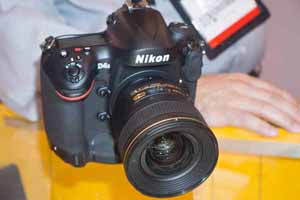 |
Although it’s a better performer in several respects, the new D4s is lighter weight than the predecessors D4 and D3s.
Nikon’s rep Paul Van Allen told me that the the D4s is already available. Price for the D4s body is steep $6,500.
Written by: Arnie Lee
Removing the Shakes
30th March 2014
Stabilizers for Shooting Video
As I was making my way through the 300+ exhibitor booths at this month’s Wedding & Portrait Photographers International Expo I was reminded how important video has become to this part of the photo industry.
For quality smooth videos, photographers rely on stabilizers to remove the shakes. At the lower end of the spectrum is the iPhone and GoPro. With proper stabilization, these cameras are capable of shooting very decent videos.
Tiffen has two accessories: one for iPhone and another for the GoPro Hero: the Curve and the Smoothee.
|
| |
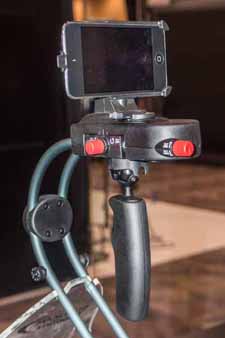 The “Smoothee” is for an iPhone |
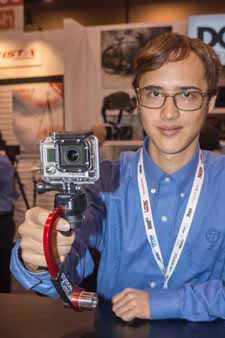 The “Curve” is a lightweight stabilizer for the GoPro Hero |
|
The Steadicam Smoothee is a small single handle device with a quick-release mount for the iPhone. It sells for $150. For more information, please visit Steadicam Smoothee The Steadicam Curve is specifically designed and balanced for the various models of the GoPro Hero. The price is $100 and is available in four colors. For more information, please visit Steadicam Curve Both the Smoothee and the Curve are lightweight and allow the photographer to easily move alongside the subject while recording smooth videos. For larger cameras, a solid tripod with a robust fluid head is most often used. But for hand-held applications, photographers will want to turn to a portable video rig. One such rig is the Comodo Orbit. | |
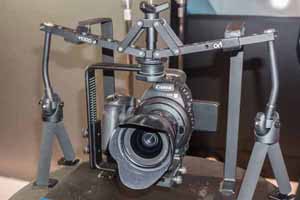 The “Orbit” stabilizer from Comodo is designed for much larger cameras. |
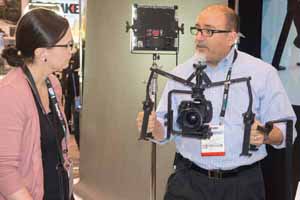 This is a lightweight, hand-held gimbal rig built for DLSRs |
The twin grips make the rig easier to handle especially when shooting for extended periods of time. The grips also double as a floor stand. With its gimbal mount, the camera is free to pivot to its stabilized position. The Orbit sells for $1500. For more information please visit Comodo.
Written by Arnie Lee
« Older Posts — Newer Posts »
